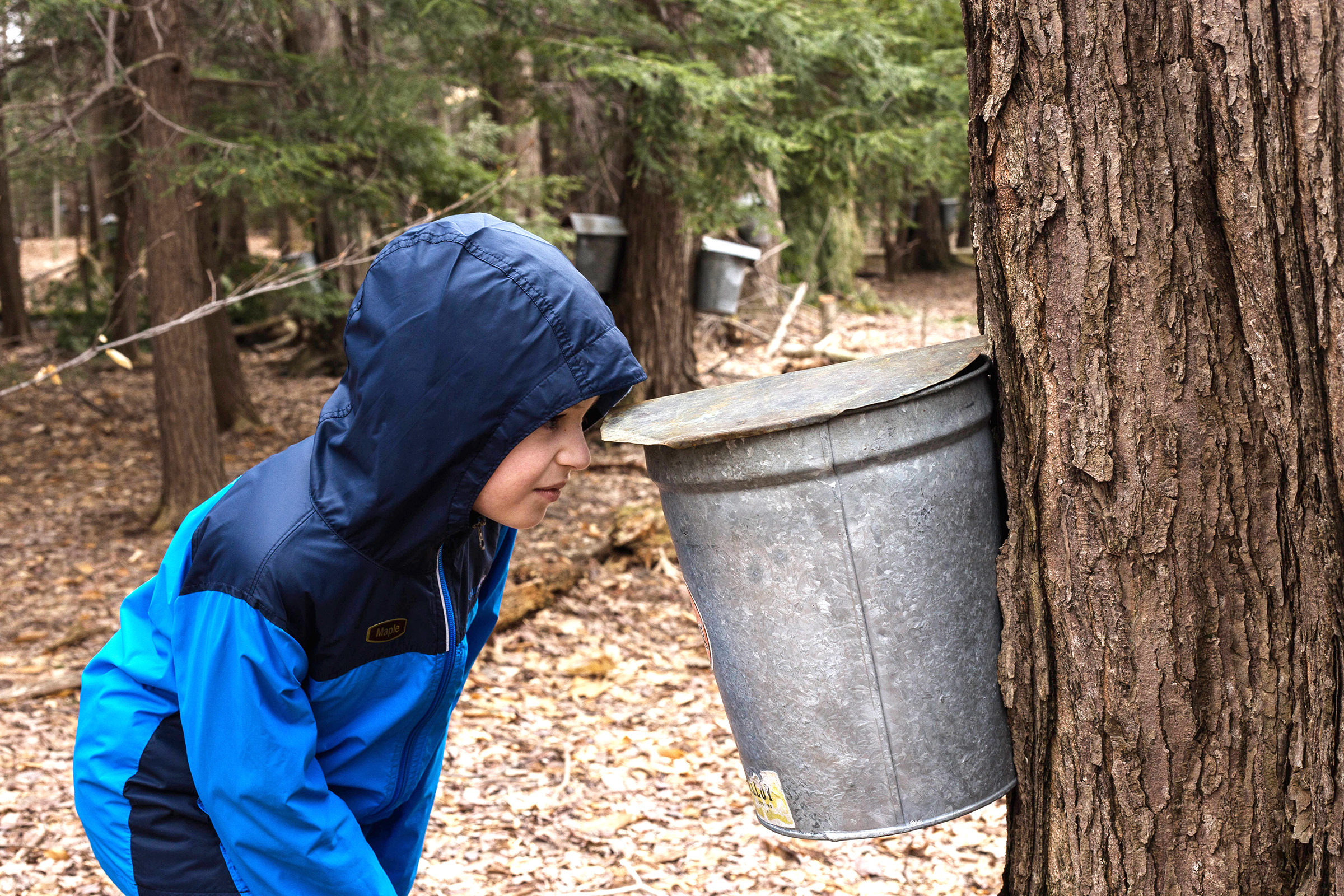Maple

Maple Festival | March 4 & 5, 2023
The annual Maple Festival is a celebration of a heritage unique to our region. Sugar maple trees are a natural resource found only in our region of the world, and Asbury Woods proudly partakes in this tradition each year by tapping trees then collecting and boiling sap into pure maple syrup!
Time: 10:00 am - 4:00 pm
Tickets: $6, Children 3 and under are free
Pre-registration preferred
Sponsored by :

More ways to enjoy Maple Season
Join the Maple Brigade
We are looking for volunteers to help run the evaporator to boil the sap we collect. This opportunity includes hanging out in our sugar shack, feeding the fire frequently to keep the sap temperature up, and describing the process to any members of the public who happen to stop by. If you enjoy sitting by a fire and the smell of warm sugar, this is for you!
Sign up for our Sugar Shack Training for volunteers | February 10
Date: Friday, February 10
Time: 10:30 am – 12:00 pm.
Age: Adults ages 18 years and up
Location: Nature Center
Attend a Progam
Backyard Maple Syrup Production| February 18
It’s maple season at Asbury Woods and in your yard! Come and learn the basics of how maple syrup was discovered, how to identify and tap a maple tree, how to process maple sap into syrup, and canning the finished product. Participants will take home a sap collecting kit for use on one tree and a reference book. The program fee is per kit.
Date: Saturday, February 18
Time: 2:30 – 4:30 p.m.
Age: Adults and children 12 years and up
Location: Nature Center
Supporting Donor Fee: $25
Program Fee: $30
Drop-in and Discover | February 18 & 25
Where does maple syrup come from? Maple trees! Join us to learn how to tap maple trees with hands-on demonstrations.
Date: Saturday, February 18 and 25
Time: 1:00 – 2:00 p.m.
Age: Children, accompanied by an adult
Location: Nature Center
FREE
No pre-registration is required.
Sap Boiling Notices
Watch for sap boiling notices on Facebook, then come and visit the Sugar Shack to see the process first-hand and learn more about the maple syrup process!
Shop Maple Products
The Nature Center Gift Shop carries a variety of maple products year-round from local producers. Purchase pure maple syrup for eating or gifting, enjoy the sweetness of maple candy, and discover maple-based seasonings for your new favorite recipes. Gift Shop hours are Monday through Saturday from 10 am - 4 pm and Sunday from 12:00 - 4 pm.
Production
Maple syrup production is a unique and tasty spring tradition in the Great Lakes and Northeastern regions of the United States and Southeastern Canada. While the science of turning maple sap into syrup is simple, the process is time consuming and relies heavily on specific weather conditions.
Throughout the summer months, trees and other plants are using the green chlorophyll in their leaves to convert sunlight, carbon dioxide, and water into oxygen and sugar, a process called photosynthesis. The sugar mixes with water to create sap and flows through the inner layers of the tree, fueling the tree’s growth. When the leaves begin to change color in the fall, the sap flows into the roots and lower trunk of the tree, where it is stored for the winter. In the spring, warmer temperatures cause slight pressure changes in the inner layers of the trees, pulling the sap up from the roots to the branches to feed the developing leaf buds. This time in the early spring before the new leaves burst from their buds is when sap can be collected for syrup production.
Although all plants produce sap for their own food, not all sap can be turned into food for humans. Sugar maples, red maples, and silver maples all have a high enough sugar content in their sap, averaging 1% - 3%, that the sap tastes sweet when boiled. Other trees produce sap with a bitter taste or sap that is poisonous, such as the sumac tree. Identifying a maple tree is the first step to producing delicious syrup. Sugar maple leaves are the most recognizable type of maple leaf with their five lobes (sections of the leaf), smooth sides, and “U” shaped sinuses (the space between the lobes). Red maple tree leaves also have five lobes but with “V” shaped sinuses and ridged sides. Silver maple leaves are similar to a red maple with longer, narrower lobes. Leaf shape is the easiest way to identify a tree but other features can be used as well. Maple trees have an opposite branching pattern, bark that is rough on the lower portion of the tree but smooth towards the top, and dual winged “helicopter” seeds.
Preparation
Preparation for the “first run” of sap begins in late January to early February, with spiles, buckets, sap lines, and evaporators being cleaned and maple syrup makers closely watching the weather reports for the perfect sap run conditions: below freezing over night with at least a twenty degree temperature increase to above freezing during the day. When favorable conditions appear in the extended forecast, it’s time to tap the maple trees. Tapping a maple tree requires slowly drilling a 1 – 2 inch deep hole into the sapwood layer of the tree. After any wood shavings are cleared from the hole, a metal or plastic spile is gently tapped into the hole using a hammer. Most maple producers can tell when the spile is at the correct depth by a change in the pitch of the hammer hitting the spile from a high pitched “ting” to a lower pitched “thunk”. After the spile is in the tree, a bucket can be hung or a tube attached to collect the sap.
Turning sap into syrup is as simple as removing water. However, since maple sap is 97 – 99% water, at least 40 gallons of sap must be collected to produce 1 gallon of maple syrup. Most large scale producers must collect hundreds of gallons of sap before beginning the evaporation process. After enough sap has been collected, it is poured into an evaporator, a multi-chambered pan on top of a large fire box. The sap is heated and maintained at boiling for several hours, allowing the water in the sap to turn to steam and evaporate out a chimney into the air. As the water evaporates, the sugar content and density of the sap increases, with fresh sap flowing into the back of the evaporator and pushing the denser liquid into the third section of the evaporator pan. When the liquid in the third chamber reaches 66% sugar content, it is officially maple syrup! Producers can then slowly begin to pour off the syrup for packaging, keeping an eye on the sugar content and temperature of the syrup.
